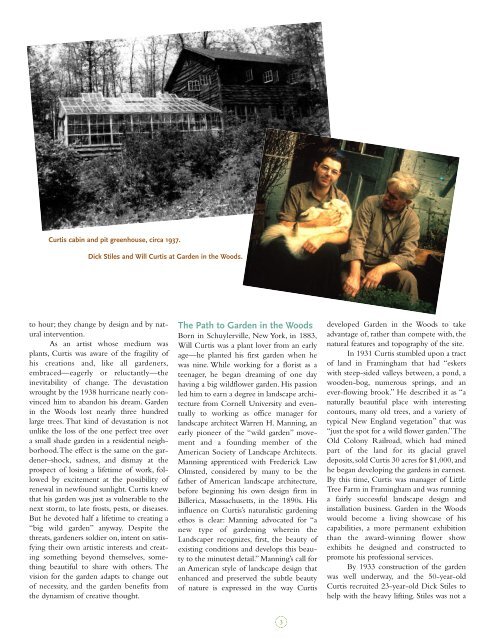(R)evolution: - American Society of Landscape Architects
(R)evolution: - American Society of Landscape Architects
(R)evolution: - American Society of Landscape Architects
You also want an ePaper? Increase the reach of your titles
YUMPU automatically turns print PDFs into web optimized ePapers that Google loves.
Curtis cabin and pit greenhouse, circa 1937.<br />
Dick Stiles and Will Curtis at Garden in the Woods.<br />
to hour; they change by design and by natural<br />
intervention.<br />
As an artist whose medium was<br />
plants, Curtis was aware <strong>of</strong> the fragility <strong>of</strong><br />
his creations and, like all gardeners,<br />
embraced—eagerly or reluctantly—the<br />
inevitability <strong>of</strong> change. The devastation<br />
wrought by the 1938 hurricane nearly convinced<br />
him to abandon his dream. Garden<br />
in the Woods lost nearly three hundred<br />
large trees. That kind <strong>of</strong> devastation is not<br />
unlike the loss <strong>of</strong> the one perfect tree over<br />
a small shade garden in a residential neighborhood.<br />
The effect is the same on the gardener–shock,<br />
sadness, and dismay at the<br />
prospect <strong>of</strong> losing a lifetime <strong>of</strong> work, followed<br />
by excitement at the possibility <strong>of</strong><br />
renewal in newfound sunlight. Curtis knew<br />
that his garden was just as vulnerable to the<br />
next storm, to late frosts, pests, or diseases.<br />
But he devoted half a lifetime to creating a<br />
“big wild garden” anyway. Despite the<br />
threats, gardeners soldier on, intent on satisfying<br />
their own artistic interests and creating<br />
something beyond themselves, something<br />
beautiful to share with others. The<br />
vision for the garden adapts to change out<br />
<strong>of</strong> necessity, and the garden benefits from<br />
the dynamism <strong>of</strong> creative thought.<br />
The Path to Garden in the Woods<br />
Born in Schuylerville, New York, in 1883,<br />
Will Curtis was a plant lover from an early<br />
age—he planted his first garden when he<br />
was nine. While working for a florist as a<br />
teenager, he began dreaming <strong>of</strong> one day<br />
having a big wildflower garden. His passion<br />
led him to earn a degree in landscape architecture<br />
from Cornell University and eventually<br />
to working as <strong>of</strong>fice manager for<br />
landscape architect Warren H. Manning, an<br />
early pioneer <strong>of</strong> the “wild garden” movement<br />
and a founding member <strong>of</strong> the<br />
<strong>American</strong> <strong>Society</strong> <strong>of</strong> <strong>Landscape</strong> <strong>Architects</strong>.<br />
Manning apprenticed with Frederick Law<br />
Olmsted, considered by many to be the<br />
father <strong>of</strong> <strong>American</strong> landscape architecture,<br />
before beginning his own design firm in<br />
Billerica, Massachusetts, in the 1890s. His<br />
influence on Curtis’s naturalistic gardening<br />
ethos is clear: Manning advocated for “a<br />
new type <strong>of</strong> gardening wherein the<br />
<strong>Landscape</strong>r recognizes, first, the beauty <strong>of</strong><br />
existing conditions and develops this beauty<br />
to the minutest detail.” Manning’s call for<br />
an <strong>American</strong> style <strong>of</strong> landscape design that<br />
enhanced and preserved the subtle beauty<br />
<strong>of</strong> nature is expressed in the way Curtis<br />
developed Garden in the Woods to take<br />
advantage <strong>of</strong>, rather than compete with, the<br />
natural features and topography <strong>of</strong> the site.<br />
In 1931 Curtis stumbled upon a tract<br />
<strong>of</strong> land in Framingham that had “eskers<br />
with steep-sided valleys between, a pond, a<br />
wooden-bog, numerous springs, and an<br />
ever-flowing brook.” He described it as “a<br />
naturally beautiful place with interesting<br />
contours, many old trees, and a variety <strong>of</strong><br />
typical New England vegetation” that was<br />
“just the spot for a wild flower garden.” The<br />
Old Colony Railroad, which had mined<br />
part <strong>of</strong> the land for its glacial gravel<br />
deposits, sold Curtis 30 acres for $1,000, and<br />
he began developing the gardens in earnest.<br />
By this time, Curtis was manager <strong>of</strong> Little<br />
Tree Farm in Framingham and was running<br />
a fairly successful landscape design and<br />
installation business. Garden in the Woods<br />
would become a living showcase <strong>of</strong> his<br />
capabilities, a more permanent exhibition<br />
than the award-winning flower show<br />
exhibits he designed and constructed to<br />
promote his pr<strong>of</strong>essional services.<br />
By 1933 construction <strong>of</strong> the garden<br />
was well underway, and the 50-year-old<br />
Curtis recruited 23-year-old Dick Stiles to<br />
help with the heavy lifting. Stiles was not a<br />
3
















